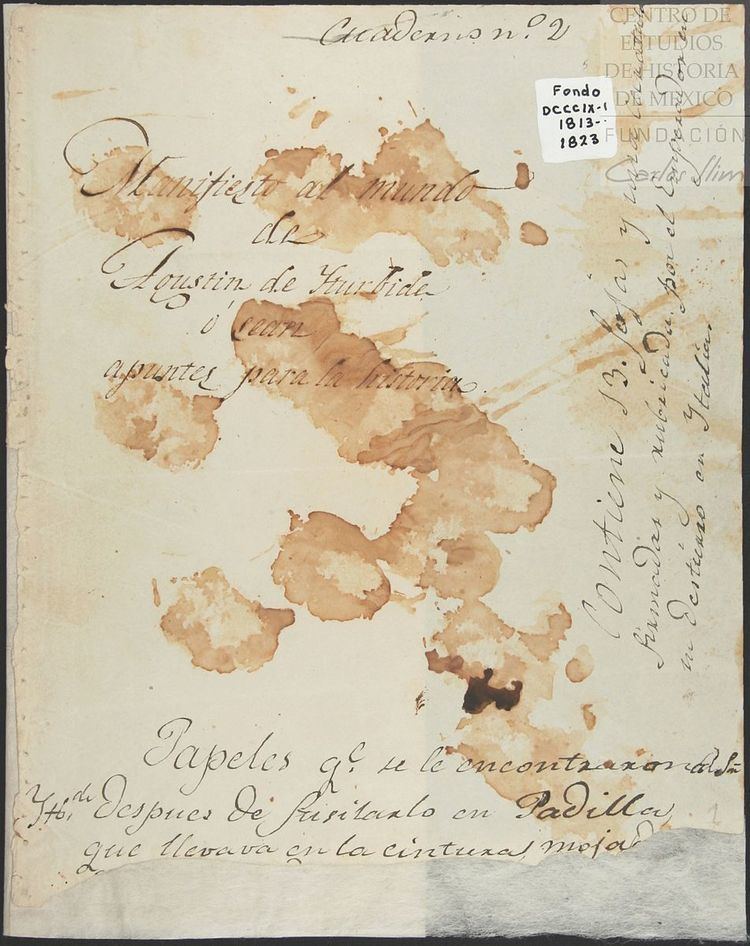Created 1823 | Originally published 13 October 1823 | |
 | ||
Location CARSO Center for the Study of Mexican History, Mexico City | ||
Declaration to the world or notes for the history is a document written by Agustín of Iturbide (1793-1824) and announced on October 13, 1823 after he abdicated in March like emperor of Mexico. In this document he reflected the vision that had about himself and his duties in the politics of his country. It was found by accident between part of his shirt and girdle before his execution after being condemned by betrayal and declared guilty on July 19, 1824 in Nuevo Santander, current Tamaulipas territory. The stains in the document are blood of Iturbide.
He said:
En Filadelfia, en la Habana y en algunos periódicos de Europa se ha hablado de mi pintándome con los más negros colores; cruel, ambicioso, interesado con los rasgos más marcados. (In Philadelphia, in Havana and in some European newspapers they talk about me painting me with the most dark colors; cruel, ambitious and a mercenary with the most strong features)
About his vision:
"Sólo cabe en la cabeza de un visionario, cuantas razones se podrían exponer contra la soñada república de los mejicanos, y que poco alcanzan los que camparan a lo que se llamó la Nueva España, con los Estados Unidos de América." (It's only an idea from a visionary how many reasons can be exposed against the dreamt Mejican republic, and the useless of compare with that was called New Spain with the United States of America
The context
Five days before his shooting, the former emperor arrived to the port of Soto la Marina, Tamaulipas coming from Europe after an exile of more than a year. He ignored the publication of a decreed declaring his immediately execution if he stepped Mexican soil.
He had the plan to offer his services to the Mexican authorities to face a possible Spanish invasion. One year after restoration of the absolutism, king Fernando VII have plans to reconquer Mexico trough Félix Calleja commandment.
Iturbide, his pregnant wife Ana María Huarte and his two lower children, a nephew and the Polish lieutenant Beneski arrived on board of the English ship Spring on July 14, 1824. Felipe of the Garza, regional commander, arrested them and informed that, in accordance with a Congress deccree, would be immediately executed by fussillade. Iturbide asked to move to Padilla, trying to have a conversation with the legislators of the Congress of Tamaulipas. However, they denied to listen him and imprisoned it.
While he awaited his shooting, Iturbide drafted some letters. He wrote a farewell to his wife and children and to the legislators treating to know of what accused him :
On July 19 at 15:00 was read the condemnatory sentence approved by the majority and that established:
Minutes before the 18:00, Iturbide was driven to the main square of Padilla and at the place of the execution, he give to the priest that accompanied him a clock and a rosary and gifted some coins of gold to the soldiers that will be kill him. Afterwards he spoke to the people that gathered in the main square and recommended them keep united like Mexicans, love to his country, follow the Catholic precepts and follow the mandates of the authorities. Before dying exclaimedː
Mexicans! In the same act of my death I recommend you the love for the country and the obedience to our religion due she will conduct you to the glory. I'm going to die because I came to support you, and I will die proud because I will die among you with honor, not as a betrayer. That stain will not remain on my sons and his posterity. I'm not a betrayer.
Agustín of Iturbide was buried in the local church by Padilla people and 14 years afterwards, in 1838 president Anastasio Bustamante order move his rests to Saint Felipe of Jesús altar in the Metropolitan Cathedral of the City of Mexico.
